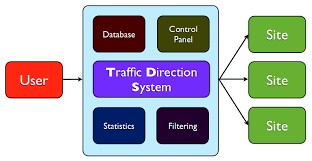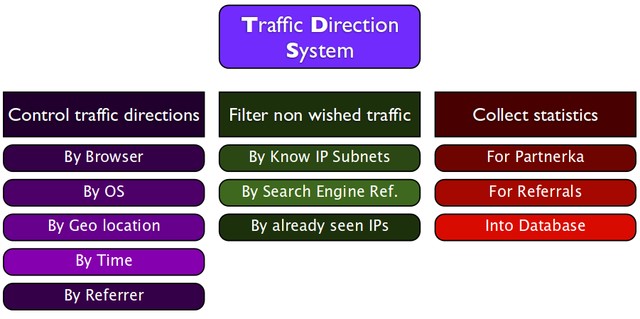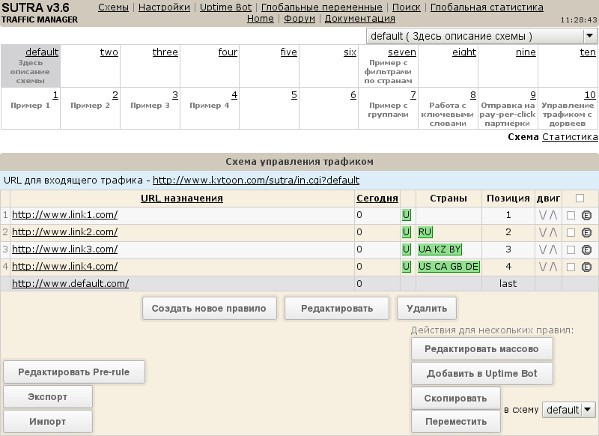It’s no secret that getting traffic is not the only task of a webmaster. Even traffic from a well-targeted context is diverse, both in terms of geo and in the browser, device type, and other parameters. You get literally a fraction of a second to decide where you are going to redirect your visitor.
This problem has been relevant for several decades, and the Traffic Delivery System (TDS) is a more or less successful solution. This is a system of scripts that, in its simplest form, analyzes the queries of the user, and, according to the rules set by the webmaster, gives this or that specific response.
In reality, there are other ways for modern TDS to learn more about the user, they keep statistics and provide flexible settings. Many affiliate marketers code TDSs on their own, or add their own plugins to popular engines; there are also services that lease already installed systems.
I propose to take a look at what TDSs can do, what can be achieved with its help. We’ll figure out when you need it and when you don’t, check out today’s leading traffic distribution products.
Table of contents
What is a TDS
As we have already said, this is a system of scripts, databases. A modern TDS is a sophisticated engine, a reliable tool for an affiliate marketer. The database can store statistics for each user (parameters, date and time, redirection info), settings and rules for redirects, which often can be very complex. The database also stores data on GeoIP – binding an address or IP range to a country, city, or even a neighbourhood.

Each visitor is analyzed in order to determine their parameters, and, in accordance with the rules set by the webmaster, is redirected to another website. This is usually the landing page of an affiliate program. An affiliate marketer selects for himself several such landing pages of various themes, designs, in order to get the maximum traffic monetization. That is exactly what the TDS is for – segmentation, choosing which is the best option to show the user.
Who can make use of a TDS and when?
A TDS is vitally important to those who deal with significant traffic flows, especially of variable quality, or with traffic that is mixed in terms of TA, GEO and other parameters. As a rule, this includes:
- Distributing visitors to different offers. Purchased traffic does not always come with the parameters declared by the seller;
- Those who get their own traffic from non-targeted sources. Especially important for doorways, because it’s difficult to manage who and how will see the promoted materials;
- Those who conduct SEO and PR campaigns to manage traffic flows from search engines, for example;
- SEO specialists, webmasters to quickly switch traffic flow between different landing pages, organize exhibit rotation, conduct AV testing;
- To drain traffic from SMM spam letters. The value is that when a link is banned, you can always create a new one, and it is difficult to predict geo when using emails.

To summarize – when dealing with large volumes of traffic and having several places to drive it to, a TDS is the best way out.
How is a TDS different from a tracker?
Further development of TDSs led to the creation of trackers, more advanced systems for affiliate marketing. They are equipped with a powerful statistical mechanism, they know how to interact with affiliate programs and traffic sources. This makes it possible to assess the quality of traffic in each flow, whether or not the choice of a landing page in terms of conversion was correct.
For those who buy traffic on exchanges, especially mixed traffic, the function of identifying bots and markups will be very useful. Having identified such a flow, you can stop it in time, avoiding a loss of funds. The tracker can also provide a report on referral sources, defining them by UTM tags, ad id, referrer, and other parameters, again by also providing all the financial analytics.
Despite how advanced trackers are, in many cases their use is impractical for economic reasons: the cost of a subscription is much higher. And it’s more difficult to set up, not everyone needs analytics functions. If the source of the traffic flow is reliable and verified, then just a TDS can handle a simple segmentation by geo or device type. For example, traffic from your own website, blog, doorway, or traffic purchased in contextual advertising systems.
You know the topic, you picked an offer for it, and now it all comes down to displaying the landing page in the correct language and format (for a specific device type), while getting quantitative statistics, and manually dealing with the conversion rate through the income figures in your affiliate program account.
Read about the best traffic sources here.
So, trackers are the next stage in the evolution of TDSs, in the future they will be able to launch campaigns from the traffic provider on their own and automatically disable ads with low CR and ROI rates. Already, trackers have built-in landing page builders with ready-made design templates.
In other words, the webmaster no longer needs to spend time on hosting, in some cases even a domain can be bought from the landing page interface. Even working with context from Facebook, Google AdWords and myTarget to name a few becomes easier, since the user is sent directly to the landing page without having to be redirected (which these networks do not allow).
When don’t you need a TDS?
From my own experience and that of our partners, I can say that you need a TDS when you’re dealing with 10k visitors a day. A smaller number of users, with little diligence, can be dispensed manually.
There’s also no need to use a TDS when all your users are redirected to a single offer since there’s nothing to segment here. Except maybe to weed out bots or get some statistics.
If you’re using SaaS (a paid subscription), then there’s also no point in buying a TDS, unless you need to configure the rules. Just to add links – something like that in theory can also provide a decent result, but it’s not a great idea to buy it for a very primitive algorithm.
How to use a TDS
First, you need to decide what type of TDS you need. There are cloud services with a paid subscription, basically, this option is you renting an already deployed system. After paying, the user gets access to their account, and it is from there that they set the rules, receive links, and monitor statistics. The advantages of such an approach are scalability (it can handle a large amount of traffic), there is no need to bother yourself with deploying and configuring the system or paying for hosting and a domain. Cons – you need to pay a monthly fee, you can’t manually change the configuration, for example, add plugins or correct something in the code.
Another way is to purchase a hosting and set up a TDS there. The webmaster gains full access to it and only pays for the hosting and domain use. Cons – you need to install the system yourself, write out the parameters for it to connect to the databases, basically – the same as installing the site engine, some technical skills are required. The next aspect is that with small traffic volumes (up to 50 thousand per day), a VDS is enough, and with large volumes or peak loads, you’ll need a dedicated server.
How to install it
There are three ways to get a distribution kit for installing on your hosting.
The easiest one is to use free TDSs. They have enough features for a beginner affiliate marketer that deals with small traffic volumes. Hosting requirements are minimal, you don’t need to use expensive tariffs. Paid versions offer more features and functions, but for training purposes the free ones are sufficient. Later on, when the webmaster can actually say what they need and don’t need, they can choose a paid version. Installation is usually simple, free TDSs are found in public repositories and are installed and configured by the package manager. If you know how to code, you can download the source code, add the functions you want, and compile the system from them.
Paid TDSs offers extensive functionality, statistics analysis, complex redirect parameters. You’ll have to pay not only the developer (either by purchasing a one-time product, or by purchasing a subscription – on average from 1,500 rubles per month), but also rent powerful equipment. Many paid products cannot be installed on entry-level hosting. In most cases, the code is encrypted, it cannot be edited, however, this is compensated by the numerous settings and the ability to add plugins.
For fairness’ sake we’ll also mention that they are pirated versions of paid TDSs. Obviously, whoever hacked the distribution did it for a reason. Pirated versions are full of backdoors and trojan horses. From experience I can tell you that you shouldn’t just brush stuff like this off, the risks are significantly higher than when using regular pirated PC software.
Relevant TDSs in 2020
TDSs have been used for a very long time, new products appear, old ones get improved. Once just some scripts with settings in a TXT file, TDS have now become not only a complex system but also a cloud service and gave birth to the next step – trackers.
Let’s take a look at a few of the most popular ones, from a free system for affiliate marketing newbies to a real monster in the business of distributing visitors, meant for the masters of traffic management.
zTDS
This TDS is a great choice for both a beginner and experienced webmaster. A server one, in other words, it’s installed on a hosting (installing it is about as simple as installing WordPress), not very demanding in terms of resources. Most importantly, it is free, so there are no restrictions on traffic or time of use. It is supplied as a set of open-source PHP scripts, which is a good for writing your own TDS (if you know how to code, of course).

It has an ascetic design, but its usability is excellent, no special explanations are required to get started. In the admin panel, you can create flows by combining them into groups. The flows can be configured according to the following traffic characteristics:
- zTDS.ru
- GEO. Segmentation is available both by countries and regions (countries are written in English, regions – via specific codes);
- Device types: tablets, PCs, phones, Smart TVs etc.;
- In addition, WAP traffic can be divided by mobile operators (MTS, Beeline) and by countries;
- Includes all widespread platforms;
- Filters that separate specific IPs, countries, browsers, or referrers (or those without a referrer);
- Bots, both search and click bots;
- Basic statistics are available for groups and flows.
Conclusion – zTDS is an entry-level system, suitable for those who have just started to harness the skill of affiliate marketing, or just for simple tasks.
KeitaroTDS
Keirtaro is a server TDS, for its full use, you should purchase a subscription to a paid tariff plan (base price – $25 per month). The free trial allows you to use the system for 7 days, during which you can launch 2 campaigns with 2 flows each, and there’s only one filter available. There are no restrictions regarding the amounts of traffic during the trial period. There’s a Russian layout, quality tech support, which isn’t very surprising, considering it’s a paid product.
Keitaro’s developers are already calling their service a tracker, and it really has outgrown the functionality of just a TDS. The cloaking settings allow you to work with ad networks with strict moderation.
The pre-installed filter sets for AV testing will allow you to get started right away, even without the right skills. The also built-in templates interact with 100+ ad networks via API, you can connect your own sources as well.
For owners of SEO agencies, there is a system for creating subaccounts in which you can set up access privileges. Colleagues will be able to edit campaigns, and clients can view statistics and reports.

The database of known bots is updated monthly ( it currently contains half a million entries).
Conclusion – this TDS is a great low-cost tool for the average-level affiliate marketer or a business owner. I also recommend it to people who want to switch from TDSs to trackers – it’s a great way to find out how much you really need (or don’t) a tracker’s features.
Sutra TDS
One of the oldest and most respected TDSs, it’s also paid (the price starts at $200, this is a one-time purchase). The system is installed on the buyer’s server.
The developers focus on stability and speed. The system itself is not a script, but a full-fledged server application written in C without using MySQL. Even on a server with an average capacity, developers promise 20 million visitors per day without the speed of redirection or content delivery slowing down.
The functionality provides for the rotation of materials according to rather complex conditions, several redirect methods (including the generation of obfuscated unique Javascript). When filtering traffic, you can discern visitors that use a proxy or those that came from the affiliate network.

When using Sutra the webmaster is free to create any additional algorithms and conditions, a filter system for any criteria, segmentation by days of the week and hours, statistics charts – with this system even affiliate marketing experts will discover new opportunities.
Because the system focuses on reliability when distributing traffic, you have the ability to constantly monitor the landing page. It is checked for availability, identity (protection against cloaking by the recipient of the traffic) and even for viruses and malicious code. Should problems arise, the URL is automatically disconnected and the flow is switched to a backup one.
Conclusions
Working with traffic flows is impossible without a TDS, and the growing demand for software products creates an abundance of offers. A beginner can easily find a free TDS (zTDS, for example), and later on, once they acquire some skills and experience and understand methods of segmenting traffic into separate flows, they can have a look at paid options. Most offers have a free trial, during which you can test how stable the TDS is, see whether it has the features you’re looking for and how easy and convenient using it is.
Note that you can either install, configure and later on upgrade a TDS on your own or rent a ready-made one without having to get into all the technical details. Such options are good because they always provide up-to-date data, whether it is a GEO or bot database or parameters of working with the API of affiliate programs.




